Pouya Bashivan
Caption This, Reason That: VLMs Caught in the Middle
May 24, 2025Abstract:Vision-Language Models (VLMs) have shown remarkable progress in visual understanding in recent years. Yet, they still lag behind human capabilities in specific visual tasks such as counting or relational reasoning. To understand the underlying limitations, we adopt methodologies from cognitive science, analyzing VLM performance along core cognitive axes: Perception, Attention, and Memory. Using a suite of tasks targeting these abilities, we evaluate state-of-the-art VLMs, including GPT-4o. Our analysis reveals distinct cognitive profiles: while advanced models approach ceiling performance on some tasks (e.g. category identification), a significant gap persists, particularly in tasks requiring spatial understanding or selective attention. Investigating the source of these failures and potential methods for improvement, we employ a vision-text decoupling analysis, finding that models struggling with direct visual reasoning show marked improvement when reasoning over their own generated text captions. These experiments reveal a strong need for improved VLM Chain-of-Thought (CoT) abilities, even in models that consistently exceed human performance. Furthermore, we demonstrate the potential of targeted fine-tuning on composite visual reasoning tasks and show that fine-tuning smaller VLMs substantially improves core cognitive abilities. While this improvement does not translate to large enhancements on challenging, out-of-distribution benchmarks, we show broadly that VLM performance on our datasets strongly correlates with performance on these other benchmarks. Our work provides a detailed analysis of VLM cognitive strengths and weaknesses and identifies key bottlenecks in simultaneous perception and reasoning while also providing an effective and simple solution.
Building spatial world models from sparse transitional episodic memories
May 19, 2025Abstract:Many animals possess a remarkable capacity to rapidly construct flexible mental models of their environments. These world models are crucial for ethologically relevant behaviors such as navigation, exploration, and planning. The ability to form episodic memories and make inferences based on these sparse experiences is believed to underpin the efficiency and adaptability of these models in the brain. Here, we ask: Can a neural network learn to construct a spatial model of its surroundings from sparse and disjoint episodic memories? We formulate the problem in a simulated world and propose a novel framework, the Episodic Spatial World Model (ESWM), as a potential answer. We show that ESWM is highly sample-efficient, requiring minimal observations to construct a robust representation of the environment. It is also inherently adaptive, allowing for rapid updates when the environment changes. In addition, we demonstrate that ESWM readily enables near-optimal strategies for exploring novel environments and navigating between arbitrary points, all without the need for additional training.
Geometry of naturalistic object representations in recurrent neural network models of working memory
Nov 04, 2024



Abstract:Working memory is a central cognitive ability crucial for intelligent decision-making. Recent experimental and computational work studying working memory has primarily used categorical (i.e., one-hot) inputs, rather than ecologically relevant, multidimensional naturalistic ones. Moreover, studies have primarily investigated working memory during single or few cognitive tasks. As a result, an understanding of how naturalistic object information is maintained in working memory in neural networks is still lacking. To bridge this gap, we developed sensory-cognitive models, comprising a convolutional neural network (CNN) coupled with a recurrent neural network (RNN), and trained them on nine distinct N-back tasks using naturalistic stimuli. By examining the RNN's latent space, we found that: (1) Multi-task RNNs represent both task-relevant and irrelevant information simultaneously while performing tasks; (2) The latent subspaces used to maintain specific object properties in vanilla RNNs are largely shared across tasks, but highly task-specific in gated RNNs such as GRU and LSTM; (3) Surprisingly, RNNs embed objects in new representational spaces in which individual object features are less orthogonalized relative to the perceptual space; (4) The transformation of working memory encodings (i.e., embedding of visual inputs in the RNN latent space) into memory was shared across stimuli, yet the transformations governing the retention of a memory in the face of incoming distractor stimuli were distinct across time. Our findings indicate that goal-driven RNNs employ chronological memory subspaces to track information over short time spans, enabling testable predictions with neural data.
Towards Adversarially Robust Vision-Language Models: Insights from Design Choices and Prompt Formatting Techniques
Jul 15, 2024Abstract:Vision-Language Models (VLMs) have witnessed a surge in both research and real-world applications. However, as they are becoming increasingly prevalent, ensuring their robustness against adversarial attacks is paramount. This work systematically investigates the impact of model design choices on the adversarial robustness of VLMs against image-based attacks. Additionally, we introduce novel, cost-effective approaches to enhance robustness through prompt formatting. By rephrasing questions and suggesting potential adversarial perturbations, we demonstrate substantial improvements in model robustness against strong image-based attacks such as Auto-PGD. Our findings provide important guidelines for developing more robust VLMs, particularly for deployment in safety-critical environments.
iWISDM: Assessing instruction following in multimodal models at scale
Jun 20, 2024



Abstract:The ability to perform complex tasks from detailed instructions is a key to many remarkable achievements of our species. As humans, we are not only capable of performing a wide variety of tasks but also very complex ones that may entail hundreds or thousands of steps to complete. Large language models and their more recent multimodal counterparts that integrate textual and visual inputs have achieved unprecedented success in performing complex tasks. Yet, most existing benchmarks are largely confined to single-modality inputs (either text or vision), narrowing the scope of multimodal assessments, particularly for instruction-following in multimodal contexts. To bridge this gap, we introduce the instructed-Virtual VISual Decision Making (iWISDM) environment engineered to generate a limitless array of vision-language tasks of varying complexity. Using iWISDM, we compiled three distinct benchmarks of instruction following visual tasks across varying complexity levels and evaluated several newly developed multimodal models on these benchmarks. Our findings establish iWISDM as a robust benchmark for assessing the instructional adherence of both existing and emergent multimodal models and highlight a large gap between these models' ability to precisely follow instructions with that of humans.
Towards Out-of-Distribution Adversarial Robustness
Oct 10, 2022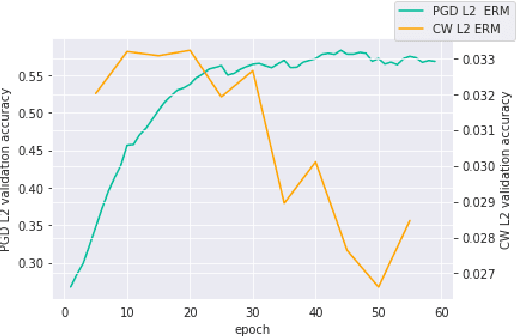
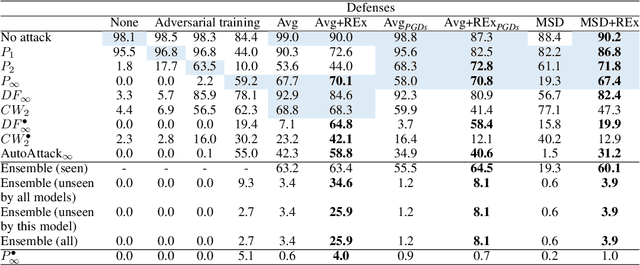
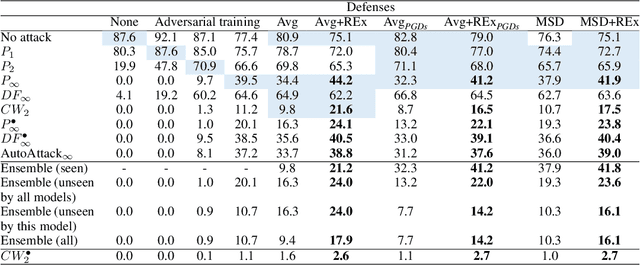
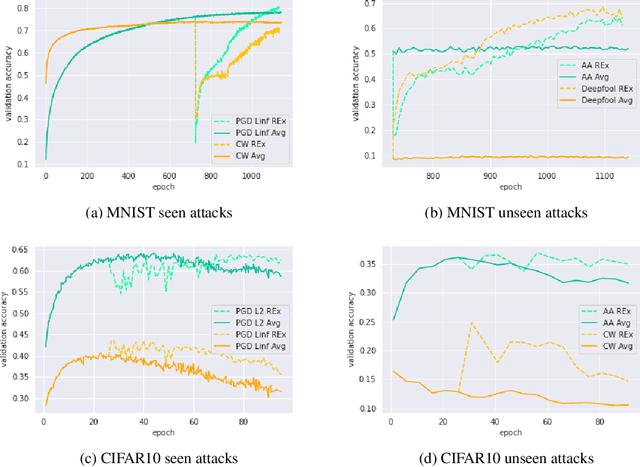
Abstract:Adversarial robustness continues to be a major challenge for deep learning. A core issue is that robustness to one type of attack often fails to transfer to other attacks. While prior work establishes a theoretical trade-off in robustness against different $L_p$ norms, we show that there is potential for improvement against many commonly used attacks by adopting a domain generalisation approach. Concretely, we treat each type of attack as a domain, and apply the Risk Extrapolation method (REx), which promotes similar levels of robustness against all training attacks. Compared to existing methods, we obtain similar or superior worst-case adversarial robustness on attacks seen during training. Moreover, we achieve superior performance on families or tunings of attacks only encountered at test time. On ensembles of attacks, our approach improves the accuracy from 3.4% the best existing baseline to 25.9% on MNIST, and from 16.9% to 23.5% on CIFAR10.
Learning Robust Kernel Ensembles with Kernel Average Pooling
Sep 30, 2022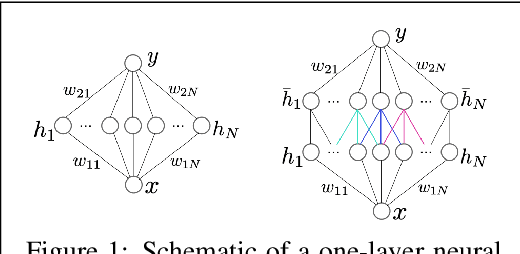
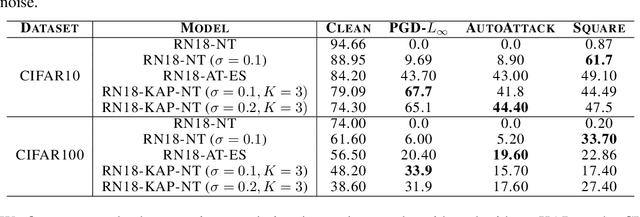

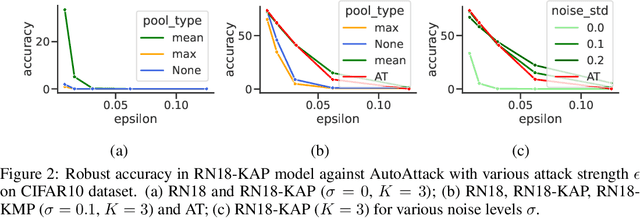
Abstract:Model ensembles have long been used in machine learning to reduce the variance in individual model predictions, making them more robust to input perturbations. Pseudo-ensemble methods like dropout have also been commonly used in deep learning models to improve generalization. However, the application of these techniques to improve neural networks' robustness against input perturbations remains underexplored. We introduce Kernel Average Pool (KAP), a new neural network building block that applies the mean filter along the kernel dimension of the layer activation tensor. We show that ensembles of kernels with similar functionality naturally emerge in convolutional neural networks equipped with KAP and trained with backpropagation. Moreover, we show that when combined with activation noise, KAP models are remarkably robust against various forms of adversarial attacks. Empirical evaluations on CIFAR10, CIFAR100, TinyImagenet, and Imagenet datasets show substantial improvements in robustness against strong adversarial attacks such as AutoAttack that are on par with adversarially trained networks but are importantly obtained without training on any adversarial examples.
Adversarial Feature Desensitization
Jun 08, 2020


Abstract:Deep neural networks can now perform many tasks that were once thought to be only feasible for humans. Unfortunately, while reaching impressive performance under standard settings, such networks are known to be susceptible to adversarial attacks -- slight but carefully constructed perturbations of the inputs which drastically decrease the network performance and reduce their trustworthiness. Here we propose to improve network robustness to input perturbations via an adversarial training procedure which we call Adversarial Feature Desensitization (AFD). We augment the normal supervised training with an adversarial game between the embedding network and an additional adversarial decoder which is trained to discriminate between the clean and perturbed inputs from their high-level embeddings. Our theoretical and empirical evidence acknowledges the effectiveness of this approach in learning robust features on MNIST, CIFAR10, and CIFAR100 datasets -- substantially improving the state-of-the-art in robust classification against previously observed adversarial attacks. More importantly, we demonstrate that AFD has better generalization ability than previous methods, as the learned features maintain their robustness against a large range of perturbations, including perturbations not seen during training. These results indicate that reducing feature sensitivity using adversarial training is a promising approach for ameliorating the problem of adversarial attacks in deep neural networks.
Brain-Like Object Recognition with High-Performing Shallow Recurrent ANNs
Oct 28, 2019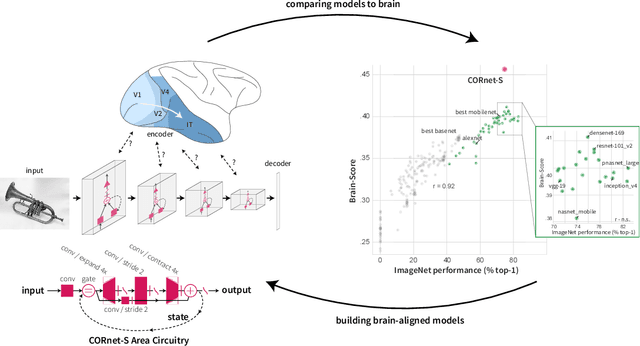
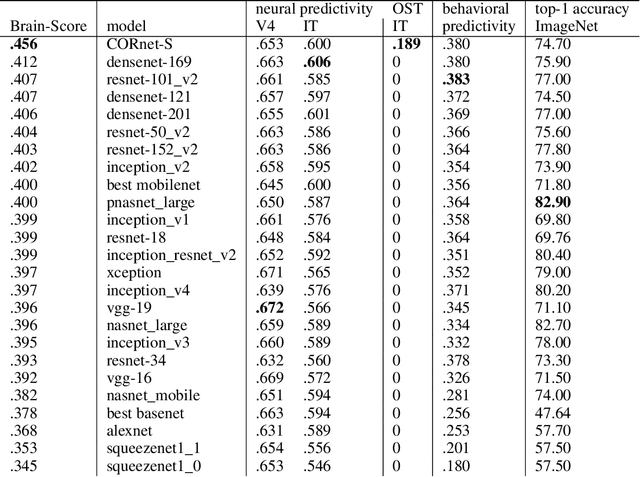

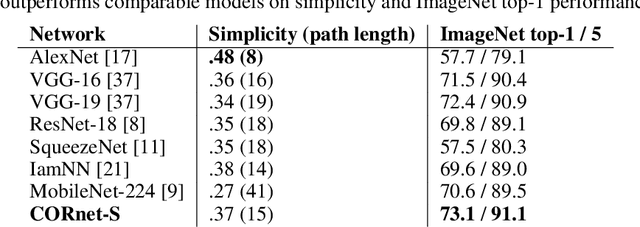
Abstract:Deep convolutional artificial neural networks (ANNs) are the leading class of candidate models of the mechanisms of visual processing in the primate ventral stream. While initially inspired by brain anatomy, over the past years, these ANNs have evolved from a simple eight-layer architecture in AlexNet to extremely deep and branching architectures, demonstrating increasingly better object categorization performance, yet bringing into question how brain-like they still are. In particular, typical deep models from the machine learning community are often hard to map onto the brain's anatomy due to their vast number of layers and missing biologically-important connections, such as recurrence. Here we demonstrate that better anatomical alignment to the brain and high performance on machine learning as well as neuroscience measures do not have to be in contradiction. We developed CORnet-S, a shallow ANN with four anatomically mapped areas and recurrent connectivity, guided by Brain-Score, a new large-scale composite of neural and behavioral benchmarks for quantifying the functional fidelity of models of the primate ventral visual stream. Despite being significantly shallower than most models, CORnet-S is the top model on Brain-Score and outperforms similarly compact models on ImageNet. Moreover, our extensive analyses of CORnet-S circuitry variants reveal that recurrence is the main predictive factor of both Brain-Score and ImageNet top-1 performance. Finally, we report that the temporal evolution of the CORnet-S "IT" neural population resembles the actual monkey IT population dynamics. Taken together, these results establish CORnet-S, a compact, recurrent ANN, as the current best model of the primate ventral visual stream.
Continual Learning with Self-Organizing Maps
Apr 19, 2019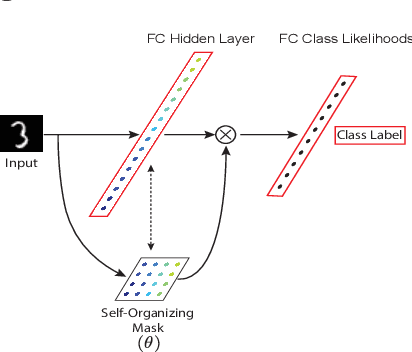



Abstract:Despite remarkable successes achieved by modern neural networks in a wide range of applications, these networks perform best in domain-specific stationary environments where they are trained only once on large-scale controlled data repositories. When exposed to non-stationary learning environments, current neural networks tend to forget what they had previously learned, a phenomena known as catastrophic forgetting. Most previous approaches to this problem rely on memory replay buffers which store samples from previously learned tasks, and use them to regularize the learning on new ones. This approach suffers from the important disadvantage of not scaling well to real-life problems in which the memory requirements become enormous. We propose a memoryless method that combines standard supervised neural networks with self-organizing maps to solve the continual learning problem. The role of the self-organizing map is to adaptively cluster the inputs into appropriate task contexts - without explicit labels - and allocate network resources accordingly. Thus, it selectively routes the inputs in accord with previous experience, ensuring that past learning is maintained and does not interfere with current learning. Out method is intuitive, memoryless, and performs on par with current state-of-the-art approaches on standard benchmarks.
 Add to Chrome
Add to Chrome Add to Firefox
Add to Firefox Add to Edge
Add to Edge